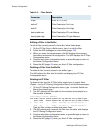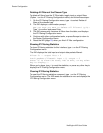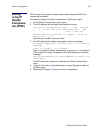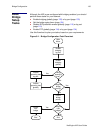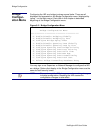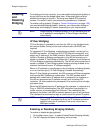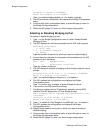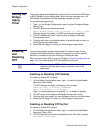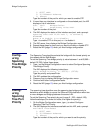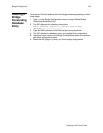
NetEngine IAD User Guide
Bridge Configuration 132
Enabling
and
Disabling
Bridging
For bridging to function correctly, you must enable bridging both globally or
by port and then set the bridge aging timer. At least two ports must be
enabled for bridging to function. You must also disable RIP poisoned
reverse. The order in which you perform the procedures is irrelevant.
To enable routing globally (Chapter 4, Router Configuration on page 103),
you must disable bridging globally. However, you may enable routing on
some ports and bridging on others, depending on your requirements.
IP Over Bridging
IP Over Bridging is intended for use then the IAD is in full bridged mode,
but remote access (Telnet) and/or user authentication (RADIUS) are
required.
To implement IP Over Bridging, enable bridging globally, and by port on
the WAN connection. (At least one DLCI/PVC must be configured), and
assign an IP address to the WAN interface. When these conditions exist
(either in Routing or Bridging configuration), the IAD will prompt you to
enable or disable IP Over Bridging. When the IP address is unconfigured,
IP Over Bridging is disabled automatically. The IAD will also prompt you to
enable or disable IP Over Bridging when bridging is being enabled on an
interface that already has an IP address assigned.
When an IP address is unconfigured or when bridging is disabled globally
or on an interface (port), IP Over Bridging is disable automatically.
When IP Over Bridging is enabled, the IAD examines all Ethernet packets
that have its MAC address as a destination. The ARP packets and IP
packets with a destination IP address that is assigned to an interface on
the IAD are processed as IP packets normally are, including APR
resolution. All other packets are processed in the usual way that a bridge
processes them.
When the IAD should send an IP packet out (for example, in response to a
Ping, or RADIUS authentication), the ARP resolution is performed in a
similar manner as accomplished on Ethernet. If the destination Mac
address is not known, the ARP broadcast request is sent to all interfaces.
The interface that receives the reply is used to send the actual IP packet.
Enabling or Disabling Bridging Globally
To enable or disable bridging globally:
1. On the Main menu, type G to select Enable/Disable Bridging Globally.
2. The IAD displays the status of bridging, and a prompt:
NOTE
When bridging is disabled globally or on an interface (port) or
an IP address is unconfigured, IP Over Bridge is disabled
automatically.
NOTE
When using IP Over Bridging with CopperMountain HDIA or
CopperVPN, the default route for the IP interface should be
specified using the IP address of the router, rather than a
WAN port number.



